Learn two easy ways to make shiitake dashi broth with dried shiitake mushrooms. Perfect for miso soup, noodle dishes, or sipping on its own.
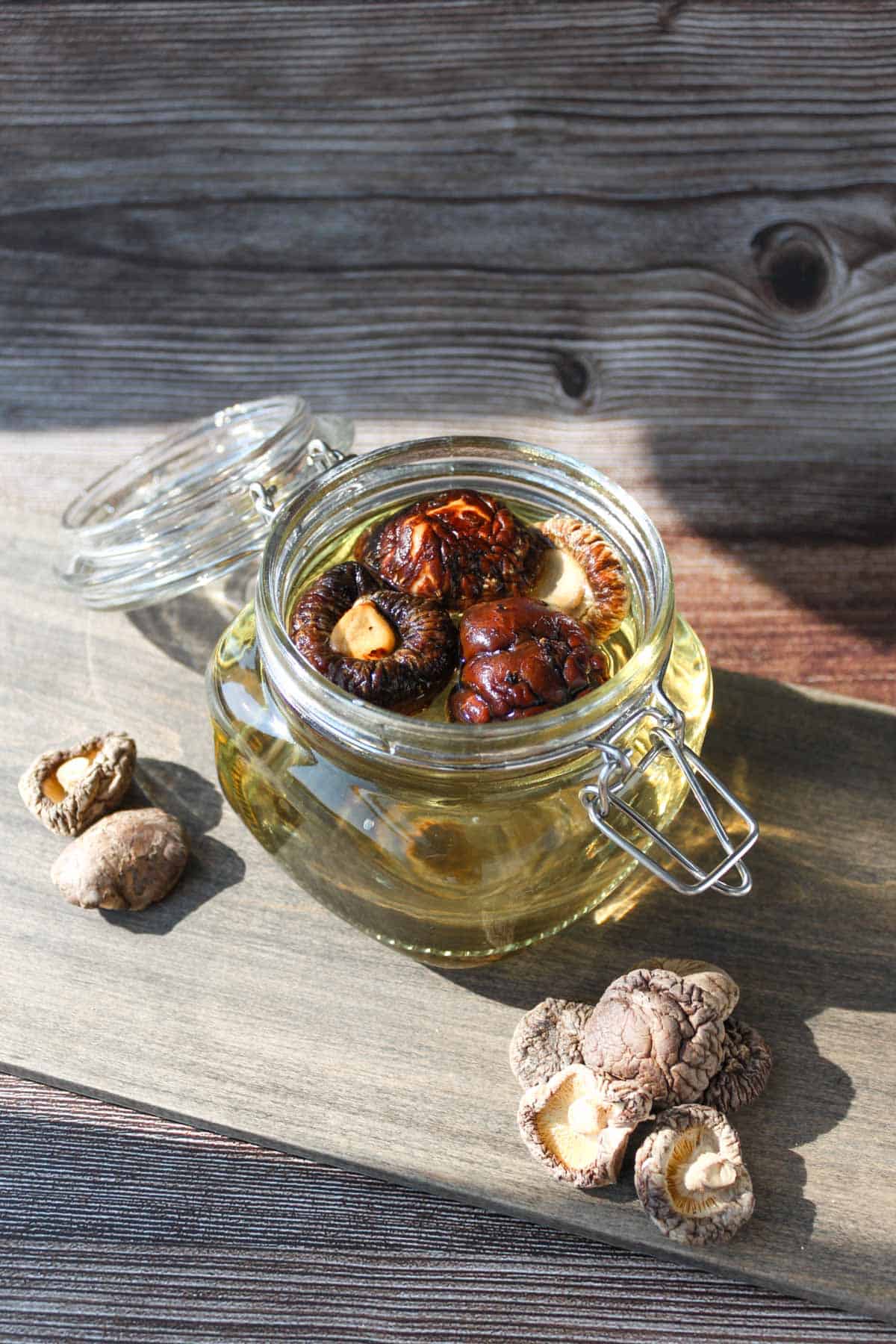
Dried shiitake is one of those magical ingredients that’s naturally packed with umami, and its unique aroma and deep flavor go perfectly with Japanese dishes.
The best part? You can reuse the shiitake after making dashi! Just slice them up and toss them into pretty much anything–miso soup, simmered dishes, or even udon noodle soup.
I’ll show you two simple ways to make shiitake dashi, so you can pick the one that works best for your schedule.
💡Curious about dashi? Check out my ultimate dashi guide to learn all about it!
Jump to:
- Why You'll Love This Recipe
- Notes on Ingredients
- What’s So Special About Dried Shiitake?
- Substitutions and Variations
- How to Make Shiitake Dashi
- Reusing Rehydrated Shiitake
- Kurumi's Tips
- How to Use Shiitake Dashi
- Storage Instructions
- FAQs
- Discover More Dashi Varieties
- 📖Recipe
- 🎁FREE Dashi Cheat Sheet
- 📌Pin This Recipe For Later!
Why You'll Love This Recipe
- Two simple ways: I’ve included two ways to make shiitake dashi, one soaks overnight and the other takes just an hour to make, so you can pick the method that fits your schedule
- No cooking required: All you have to do is soak the dried shiitake and wait. That’s it! It’s not so hard to get delicious dashi at home 🙂
- No waste: After making shiitake dashi, you can easily reuse the rehydrated shiitake just like regular mushrooms!
Notes on Ingredients
See the recipe card for the full ingredients list.
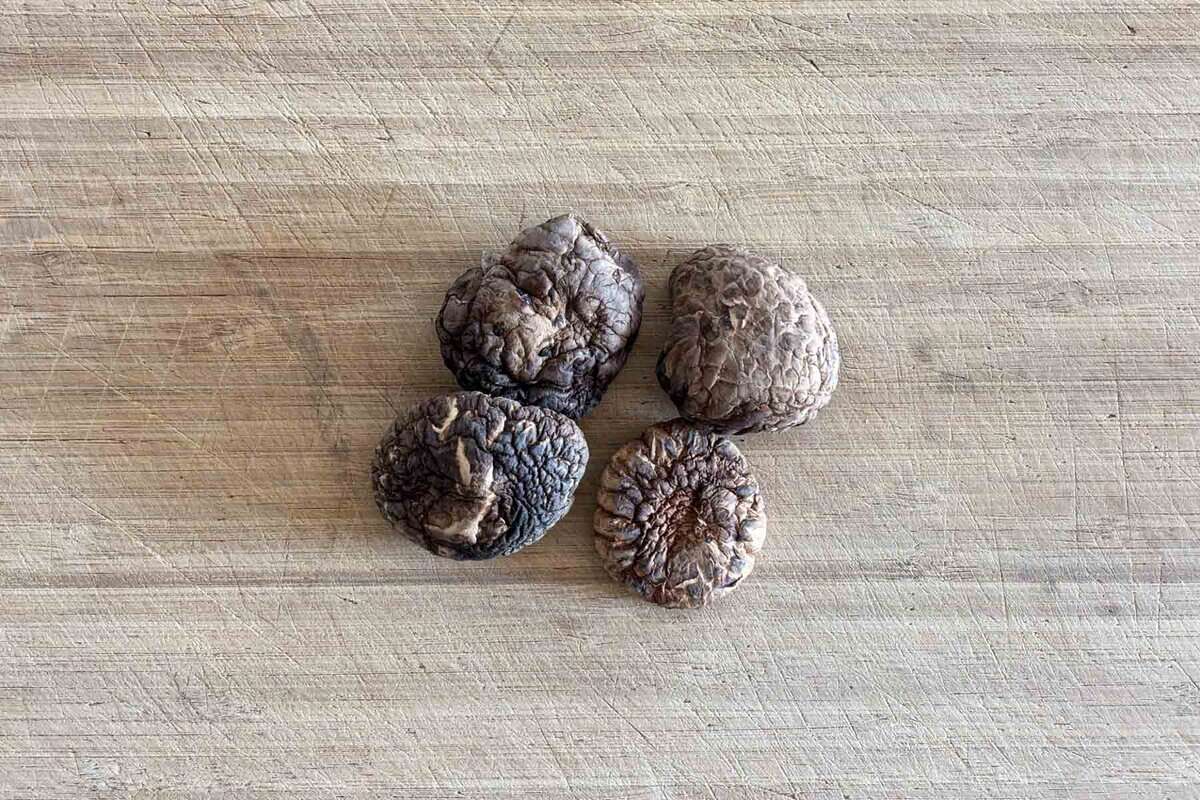
Dried Shiitake
There are two common varieties you’ll come across: Donko and Koushin. They come from the same mushroom, but they look and behave a little differently.
- Koushin mushrooms have larger, thinner caps that are more spread out. Because of their shape, they release umami more easily when soaked.
- Donko, on the other hand, have thicker, more compact caps with a rounder shape.
In terms of flavor, both are quite similar.
- If you’re aiming for a quick and budget-friendly option for dashi, go with Koushin.
- If you’re after a more meaty texture or a prettier appearance in your dishes, Donko is a great choice.
Water
Water might seem like a small detail, but it actually plays a big role in how your dashi turns out. Soft water works best because it helps draw out more of that deep umami flavor.
If your water has higher levels of minerals like calcium and magnesium (a.k.a. hard water), it can get in the way, resulting in a weaker flavor and sometimes even a cloudy or slightly bitter broth.
Since many places in the U.S. have hard tap water, I suggest using a water filter, like Brita. It’s a simple way to soften your water without having to rely on bottled soft water each time. Plus, it's more affordable and eco-conscious in the long run.
💡You can find dried shiitake and other ingredients at most Asian grocery stores, or online through places like Amazon or Weee!
What’s So Special About Dried Shiitake?
There are three main types of umami compounds:
- Glutamic acid (an amino acid)
- Inosinic acid and guanylic acid (both nucleic acids)
Research shows that when you combine an amino acid with a nucleic acid, the umami taste becomes much more intense. This effect is known as umami synergy.
Dried shiitake is one of the few ingredients naturally rich in guanylate.
Why is this important? Because if you can’t use inosinate (which is typically found in animal products), you can still create a strong umami flavor by combining guanylate from dried shiitake with glutamate, which is present in many plant-based ingredients.
Substitutions and Variations
- Dried Shiitake: It’s hard to find a true substitute for dried shiitake since very few ingredients are high in guanylic acid. While options like fresh mushrooms, sun-dried tomatoes, or even nori do contain some, their levels are much lower in comparison. If you’re in a pinch, you could try shiitake mushroom powder or go with a different type of dashi altogether, such as kombu dashi, vegan dashi, or awase dashi.
- Shortcut Options: Forgot to soak your ingredients ahead of time? No worries! Instant dashi powders can be a handy backup when you need to pull something together quickly.
How to Make Shiitake Dashi
Overnight Method
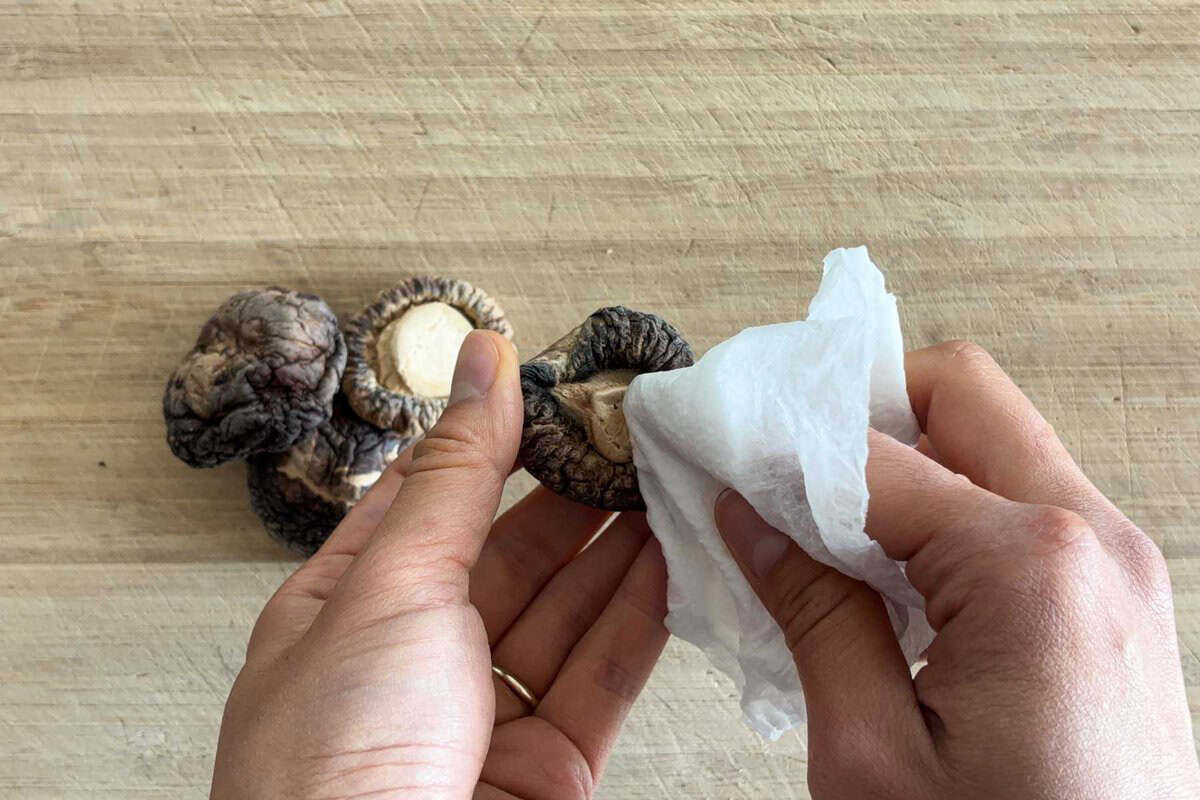
Step 1: Gently wipe the dried shiitake with a damp paper towel, or quickly rinse them under running water, to remove any dust.
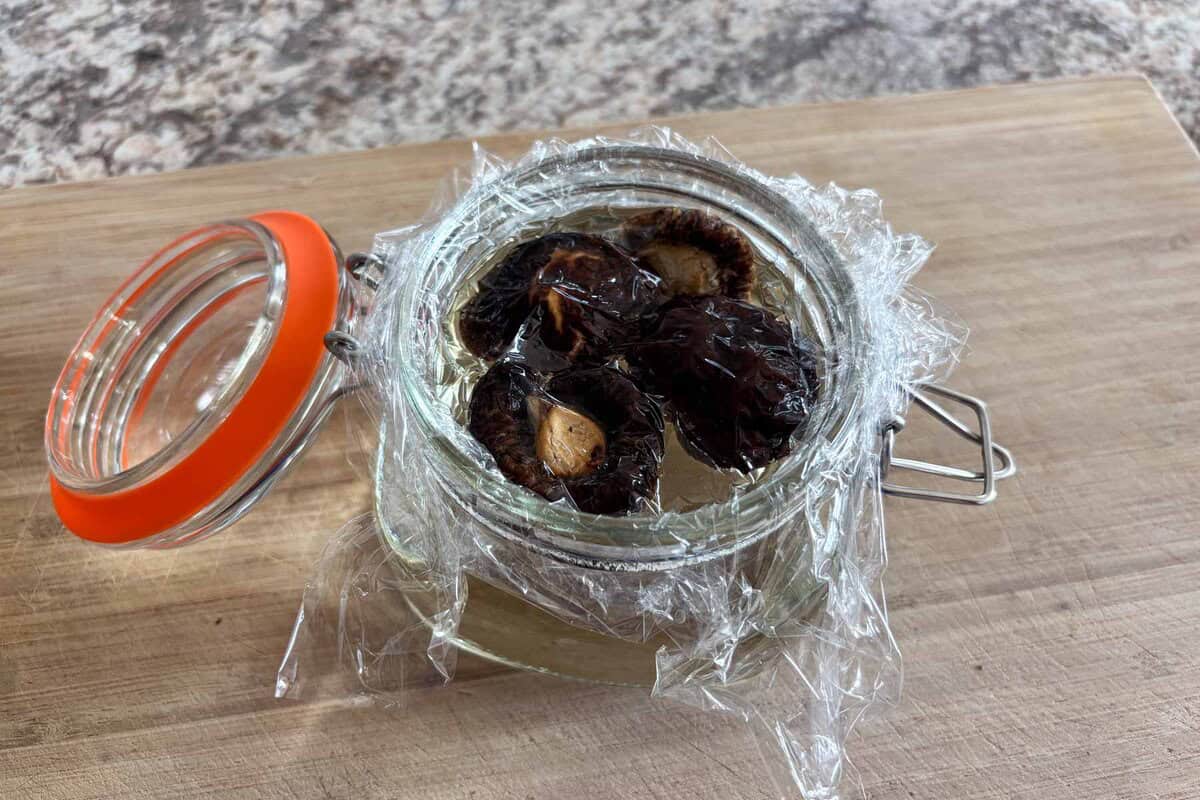
Step 2: Place them in a container and keep them fully submerged. Let them soak in the fridge for 12 to 24 hours, then remove the shiitake.
Quick Method
- Use pre-sliced dried shiitake or break whole ones into smaller pieces.
- Add them to a container, making sure they stay submerged. Chill in the fridge for about 1 hour, then remove the shiitake.
Reusing Rehydrated Shiitake
Once they’re rehydrated, you can use shiitake just like fresh mushrooms! Here are some of my favorite easy ways to enjoy them:
- Slice them up and toss them into miso soup. It instantly turns an everyday bowl into a little treat.
- Chop them and add to takikomi gohan (mixed rice) for extra flavor and texture.
- Stir them into udon noodle soup for a cozy boost.
- Or just pop the whole shiitake into simmered dishes. They add a nice flavor to the dish.
Kurumi's Tips
- Don’t boil, soak instead: The umami compound in dried shiitake, called guanylate, becomes more concentrated with gentle warming. But if you cook it too long, it starts to break down. The best way to draw out its flavor is by soaking the mushrooms slowly in cold water, then gently warming the broth right before using it in your recipe.
- Keep the mushrooms fully submerged: Dried shiitake tends to float because it’s so lightweight. To help it soak evenly and rehydrate all the way through, press a drop lid (otoshibuta), a small dish, or even a sheet of plastic wrap directly against the surface of the water. This keeps the mushrooms fully covered the whole time.
- Warm it up before using: Since the dashi isn’t simmered during the soaking process, it’s important to heat it up when you actually cook with it. Bringing it to a simmer not only enhances the flavor but also ensures it’s safe to eat by killing off any potential bacteria.
How to Use Shiitake Dashi
Shiitake dashi has a stronger aroma and deeper flavor than kombu dashi, but it doesn’t have the bold “punch” that fish-based broths like niboshi dashi or katsuo dashi offer.
That’s why it’s perfect when you’re looking for a plant-based dashi that still has a rich, well-balanced flavor.
Shiitake dashi really shines when it’s paired with glutamate-rich ingredients. Try combining it with kombu dashi for a flavorful vegan broth, or pair it with other ingredients in your dish to boost umami.
Storage Instructions
- Dashi: Store in an airtight container for up to 3 days in the fridge or 2 weeks in the freezer (ice cubes work great for small portions).
- Rehydrated Shiitake: Pat dry and store in an airtight container for up to 1 week in the fridge or 1 month in the freezer.
FAQs
Shiitake dashi is a Japanese soup stock made by soaking dried shiitake mushrooms in water. It’s plant-based and rich in umami. The taste is earthy, savory, and slightly smoky, with deep mushroom flavor. It’s commonly used in vegetarian or vegan Japanese cooking as a flavorful base for soups, stews, and sauces.
Discover More Dashi Varieties
Shiitake dashi is just one of many flavorful dashi options, and each has its own special taste and role in Japanese cooking.
Curious about how they’re different or which one suits your dish best? Take a peek at my Complete Dashi Guide. It walks you through everything from the fundamentals to ingredient advice, so you can pick the perfect dashi for your needs.
Want to explore more? Here are some other dashi recipes to try:
- 🌱 Vegan Dashi
- 🌿 Kombu Dashi
- 🐟 Bonito Dashi (Katsuo Dashi)
- 🐟 Iriko Dashi (Dried Anchovy)
- 🥣 Awase Dashi
- 🍄 Shiitake Dashi (That’s this one!)
🎁Grab your FREE dashi cheat sheet! Stick it on your fridge and skip Googling recipes every time 🙂
💌 If you tried this recipe and liked it, I’d love to hear from you! Leave a comment and review below or send a photo of your dish to my email. I’d be so happy to see your creation!
📖Recipe

Shiitake Dashi Recipe (Easy Dried Mushroom Broth)
Ingredients
Method
- Gently wipe 20 g dried shiitake mushrooms with a damp paper towel, or quickly rinse them under running water, to remove any dust.
- Place them in a container with 2 cups filtered water and cover with an otoshibuta (drop lid), small plate, or plastic wrap pressed directly on the surface to keep them fully submerged.
- Let them soak in the fridge for 12 to 24 hours.
- Remove the shiitake.
- Use pre-sliced dried shiitake or break whole ones into smaller pieces.
- Add them to a container with 2 cups filtered water and cover with a drop lid, plate, or plastic wrap so they stay submerged.
- Chill in the fridge for about 1 hour.
- Remove the shiitake.
Notes
- Water: Soft water extracts more umami. Use filtered water (e.g. Brita) if you’re in a hard water area like the U.S.
- Dried Shiitake: Choose Koushin for easier, more affordable dashi; choose Donko for a thicker texture and nicer look.
- Substitutions: Dried shiitake→ Dried tomatoes, nori seaweed, shiitake powder
- Reusing Ingredients:
Use rehydrated shiitake just like regular mushrooms:- Miso soup
- Takikomi gohan (mixed rice)
- Udon noodle soup
- Simmered dishes
- How to Use Shiitake Dashi: Pair shiitake dashi with kombu dashi or other glutamate-rich ingredients to boost umami.
- Storage Instructions:
- Dashi: Store in an airtight container for up to 3 days in the fridge or 2 weeks in the freezer (ice cubes work great for small portions).
- Rehydrated shiitake: Pat dry and store in an airtight container for up to 1 week in the fridge or 1 month in the freezer.
🎁FREE Dashi Cheat Sheet
📌Pin This Recipe For Later!


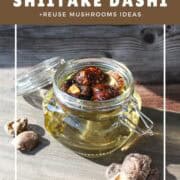
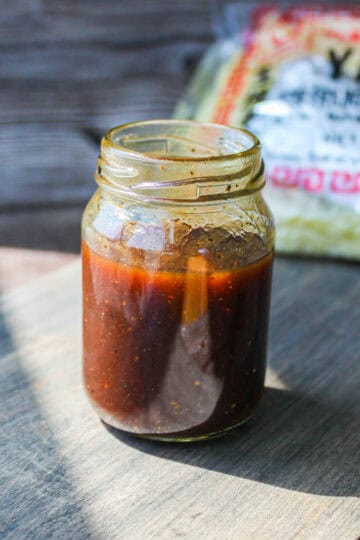

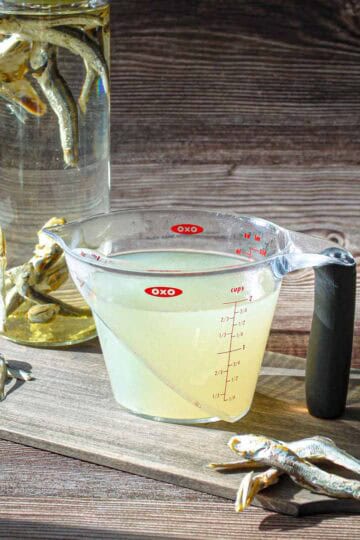
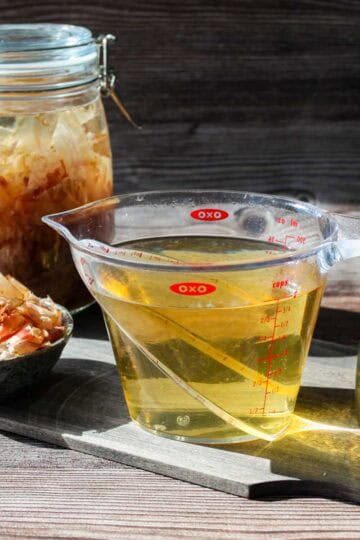
Kurumi says
I love shiitake dashi because both the dashi and the rehydrated shiitake taste so, so, so good! The dashi is super versatile. You can use it in so many dishes, and it pairs beautifully with other umami-rich ingredients like vegetables. And the rehydrated shiitake? They're soft, chewy, and absolutely delicious in simmered dishes. I just love eating them! I hope you’ll fall in love with this dashi too 🙂